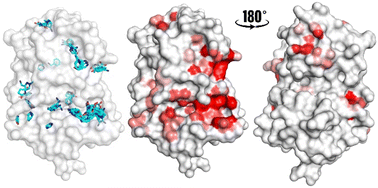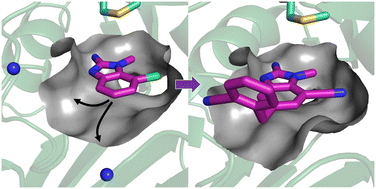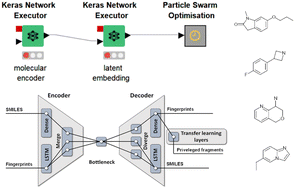Themed collection Fragment-based drug discovery

Introduction to the themed collection on fragment-based drug discovery
Guest editors David Rees, Anna Hirsch and Daniel Erlanson introduce the RSC Medicinal Chemistry themed collection on fragment-based drug discovery.

RSC Med. Chem., 2022,13, 1439-1439
https://doi.org/10.1039/D2MD90037H
Fragment screening libraries for the identification of protein hot spots and their minimal binding pharmacophores
Small molecule interaction hotpots were identified by screening small, low complexity fragments using X-ray crystallography. These hot spots include cryptic pockets and provide pharmacophore mapping that may be used in structure-based drug design.

RSC Med. Chem., 2023,14, 135-143
https://doi.org/10.1039/D2MD00253A
Revisiting a challenging p53 binding site: a diversity-optimized HEFLib reveals diverse binding modes in T-p53C-Y220C
Fragment screening of the challenging drug target T-p53-Y220C with our diversity optimized HEFLib leads to diverse reversible and covalent binding modes.

RSC Med. Chem., 2022,13, 1575-1586
https://doi.org/10.1039/D2MD00246A
Exploration of piperidine 3D fragment chemical space: synthesis and 3D shape analysis of fragments derived from 20 regio- and diastereoisomers of methyl substituted pipecolinates
The synthesis and 3D shape analysis of fragments derived from 20 regio- and diastereoisomers of methyl substituted pipecolinates is described.

RSC Med. Chem., 2022,13, 1614-1620
https://doi.org/10.1039/D2MD00239F
Fragment optimization and elaboration strategies – the discovery of two lead series of PRMT5/MTA inhibitors from five fragment hits
Herein we describe our approach to prioritize five fragment hits with the objective of answering three questions: could the binding potency be improved? Were the series chemically tractable? Could additional co-crystal structures be solved?

RSC Med. Chem., 2022,13, 1549-1564
https://doi.org/10.1039/D2MD00163B
A fragment-based approach leading to the discovery of inhibitors of CK2α with a novel mechanism of action
Development of a novel CK2α inhibitor from a fragment-based screen with a proposed novel mechanism of action.

RSC Med. Chem., 2022,13, 1420-1426
https://doi.org/10.1039/D2MD00161F
PAC-FragmentDEL – photoactivated covalent capture of DNA-encoded fragments for hit discovery
Fragments bind weakly to specific sites on proteins. A library where a photoactivatable group is linked to DNA encoded fragments covalently links the protein to binding fragments whose identity is determined by PCR and sequencing.

RSC Med. Chem., 2022,13, 1341-1349
https://doi.org/10.1039/D2MD00197G
Implementation of an AI-assisted fragment-generator in an open-source platform
We report a deep learning model to facilitate fragment library design, which is critical for efficient hit identification, and an implementation in the KNIME graphical workflow environment which should facilitate a more codeless use.

RSC Med. Chem., 2022,13, 1205-1211
https://doi.org/10.1039/D2MD00152G
19F chemical library and 19F-NMR for a weakly bound complex structure
19F-NMR analysis using the optimized 19F chemical library enables the modeling of the structure of the weakly bound protein–compound complex, overcoming the difficulty in fragment-based drug discovery.

RSC Med. Chem., 2022,13, 1100-1111
https://doi.org/10.1039/D2MD00170E
Fragment screening at AstraZeneca: developing the next generation biophysics fragment set
The evolution of AstraZeneca's fragment screening library from multiple technology sets to a single, layered biophysics set.

RSC Med. Chem., 2022,13, 1052-1057
https://doi.org/10.1039/D2MD00154C
About this collection
This themed collection, guest edited by Professor Anna Hirsch (Helmholtz Institute for Pharmaceutical Research Saarland, Germany), Dr Daniel Erlanson (Frontier Medicines, USA) and Dr David Rees (Astex Pharmaceuticals, UK; RSC Medicinal Chemistry Advisory Board member), highlights the latest medicinal chemistry advances in fragment-based drug discovery (FBDD). The collection will cover all aspects of FBDD, from the principles governing FBDD to fragment libraries and design, fragment screening technologies, computational methods and chemical synthesis for FBDD.
New articles will be added to the collection upon publication. Please return to this page frequently to see the collection grow.